药品滴定分析方法集
- 格式:pdf
- 大小:730.36 KB
- 文档页数:4
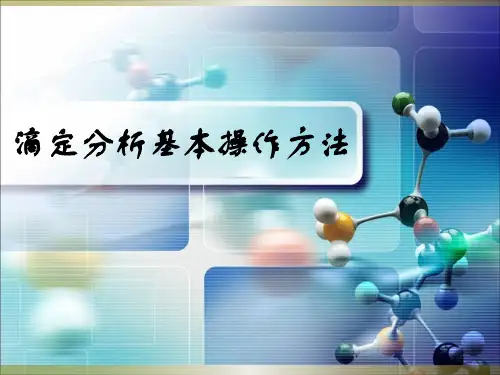

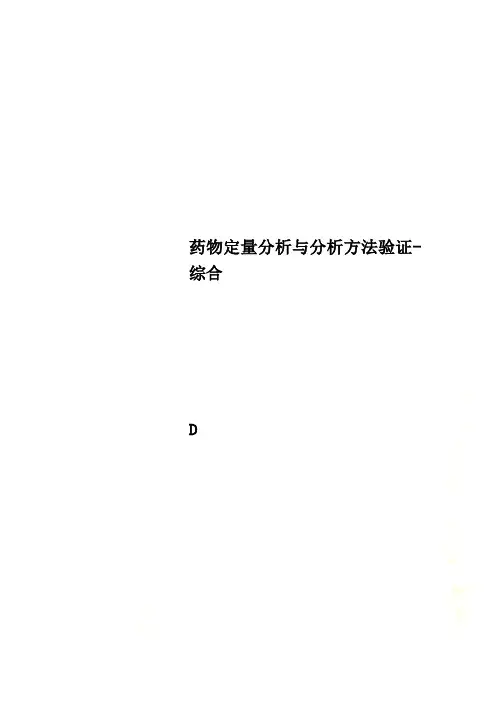

滴定分析法在药物分析中的应用滴定分析的主要方法有:①根据滴定分析的方式不同,滴定分析法可分为:(1)直接滴定法。
(2)间接滴定法。
(3)返滴定法,又称剩余量滴定法或回滴定法。
(4)置换滴定法。
②根据滴定反应类型的不同滴定分析法又可分为:(1)酸碱滴定法,又称中和法。
(2)配位滴定法,旧称络和滴定法。
(3)氧化还原滴定法。
(4)沉淀滴定法。
滴定分析法作为标准分析方法之一,被广泛应用在医药行业:进行简单,快速,具有重现性和准确性的有效成分,药品及其原料的分析(含量测定)。
滴定尤其适合于生产过程中的质量控制和常规分析。
以下为一些主要的应用:1.具有药物活性物质的纯度分析滴定主要用于测定药物活性成分的含量,如:阿斯匹林中的乙酰水杨酸或复合维他命片剂中的维生素C,以及用于药物合成的药物添加剂的含量测定和纯度控制。
酸碱中和反应等酸碱滴定是医药行业用得最多的滴定。
一个典型的例子就是盐酸麻黄碱的纯度控制[1]。
该成分通常出现在咳嗽糖浆中,用以治疗支气管哮喘。
其含量的测定是在含有无水醋酸和醋酸汞的有机溶剂中,用高氯酸作滴定剂进行滴定:2R-NH3+-Cl-+Hg(OAc)2 =2R-NH2+HgCl2+2HOAcR-NH2+HClO4 =R-NH3+-ClO4-2.用氧化还原滴定进行成分分析氧化还原滴定通常被用来检测原料、填充物和防腐剂的纯度。
例如,4-苯甲酸甲酯(一种对羟基苯甲酸酯)中溴值的测定。
这种化合物作为防腐剂被应用于眼药制剂和外用眼药膏中。
硫代硫酸钠被用作滴定剂。
整个分析由下述几个步骤组成:酯与氢氧化钠的皂化作用(水解)羟基氧化到酮基的过程苯环的(亲电)溴化过量的溴与碘离子反应,生成滴定过程中所需的游离碘碘经硫代硫酸盐滴定,还原成碘离子:I2+2S2O32-=2I-+S4O62-3.沉淀滴定某些药品由于其结构的关系,在滴定过程中会有沉淀析出。
例如,氯化亚苄翁。
通常用四苯基硼酸钠或是十二烷基磺酸钠作为滴定剂,用梅特勒-托利多DS500表面活性剂电极或是DP550光度电极就可以进行滴定。
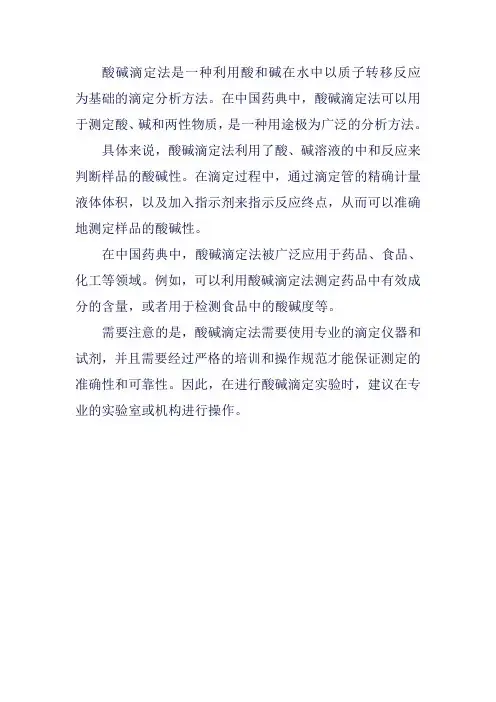
酸碱滴定法是一种利用酸和碱在水中以质子转移反应为基础的滴定分析方法。
在中国药典中,酸碱滴定法可以用于测定酸、碱和两性物质,是一种用途极为广泛的分析方法。
具体来说,酸碱滴定法利用了酸、碱溶液的中和反应来判断样品的酸碱性。
在滴定过程中,通过滴定管的精确计量液体体积,以及加入指示剂来指示反应终点,从而可以准确地测定样品的酸碱性。
在中国药典中,酸碱滴定法被广泛应用于药品、食品、化工等领域。
例如,可以利用酸碱滴定法测定药品中有效成分的含量,或者用于检测食品中的酸碱度等。
需要注意的是,酸碱滴定法需要使用专业的滴定仪器和试剂,并且需要经过严格的培训和操作规范才能保证测定的准确性和可靠性。
因此,在进行酸碱滴定实验时,建议在专业的实验室或机构进行操作。

滴定分析方法举例一、酸碱滴定1、烧碱中NaOH 与32CO Na 含量的测定(双指示剂法)2、硼酸的测定(强化法)由于硼酸酸性极弱,不能用NaOH 直接测定,相溶液中加入大量的甘露醇,可生成26.4=a pK 的强酸性物质,可用NaOH 直接滴定。
3、42HPO Na (133104.4-⨯=Ka )的测定(沉淀强化法):由于42HPO Na 酸性较弱,通常向其中加入钙盐使其生成243)(PO Ca 沉淀,解离出氢离子以便滴定。
4、亚硫酸的测定(氧化还原强化法)用碘、双氧水等将其氧化成硫酸在进行滴定。
5、钢铁与矿石中磷的测定在硝酸介质中磷酸与钼酸铵反应可生成黄色的磷钼酸铵沉淀OH O H O HPMo NH H NH MoO PO 22401224443411)(25212+↓∙=++++++-沉淀用经过滤用水洗涤后将其溶于一定量的过量的NaOH 标准溶液中OH NH MoO PO OH O H O HPMo NH 23243424012241621227)(+++=+∙---过量的NaOH 用3HNO 标准溶液返滴定至酚酞刚好褪色(pH 约为8),此时由下列3个反应发生,磷与NaOH 的实际化学计量比为1:24++-+-+-=+=+=+4324342NH H NH HPO H PO OH H OH 6、硅酸盐中硅的测定(氟硅酸滴定法)试样用KOH 熔融转化为32SiO K ,32SiO K 在钾盐下与HF 反应生成62SiF K (沉淀),沉淀洗涤后加入氯化钾-乙醇溶液用NaOH 中和掉游离酸(至酚酞变红),再加入沸水使62SiF K 水解出HF ,最后再用NaOH 标准溶液滴定。
32CO Na NaOH +3NaHCO NaCl酚酞HCl(V1)甲基红HCl(V2)HFSiO H KF O H SiF K 42332262++=+7、铵盐的测定(蒸馏法)向铵盐试液中加入NaOH 加热,用33BO H 吸收氨气,选用甲基红与溴甲酚绿混合指示剂,用标准硫酸溶液滴定至灰色为终点。
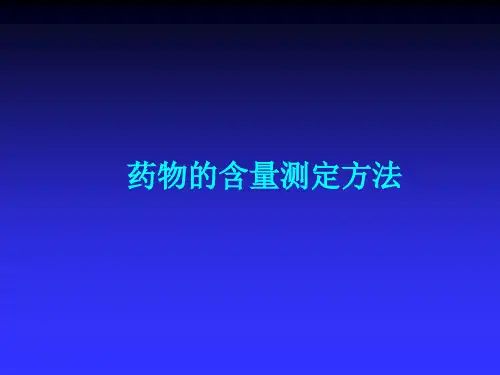
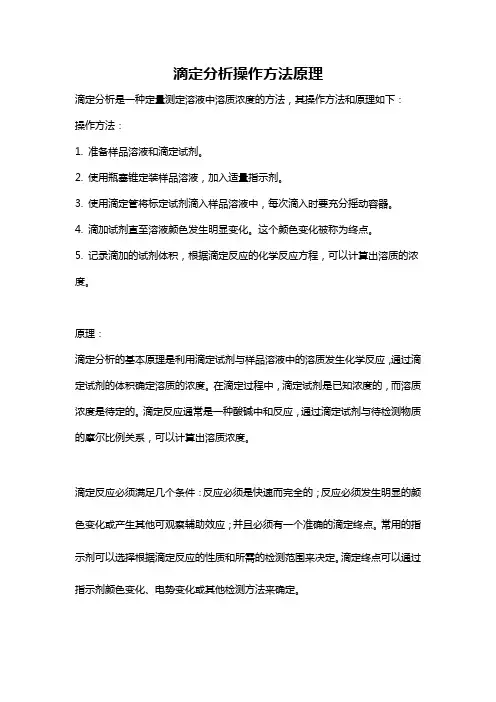
滴定分析操作方法原理
滴定分析是一种定量测定溶液中溶质浓度的方法,其操作方法和原理如下:
操作方法:
1. 准备样品溶液和滴定试剂。
2. 使用瓶塞锥定装样品溶液,加入适量指示剂。
3. 使用滴定管将标定试剂滴入样品溶液中,每次滴入时要充分摇动容器。
4. 滴加试剂直至溶液颜色发生明显变化。
这个颜色变化被称为终点。
5. 记录滴加的试剂体积,根据滴定反应的化学反应方程,可以计算出溶质的浓度。
原理:
滴定分析的基本原理是利用滴定试剂与样品溶液中的溶质发生化学反应,通过滴定试剂的体积确定溶质的浓度。
在滴定过程中,滴定试剂是已知浓度的,而溶质浓度是待定的。
滴定反应通常是一种酸碱中和反应,通过滴定试剂与待检测物质的摩尔比例关系,可以计算出溶质浓度。
滴定反应必须满足几个条件:反应必须是快速而完全的;反应必须发生明显的颜色变化或产生其他可观察辅助效应;并且必须有一个准确的滴定终点。
常用的指示剂可以选择根据滴定反应的性质和所需的检测范围来决定。
滴定终点可以通过指示剂颜色变化、电势变化或其他检测方法来确定。

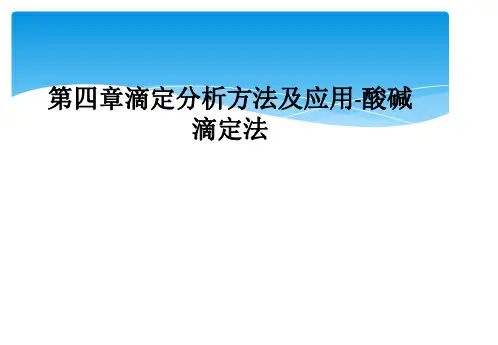
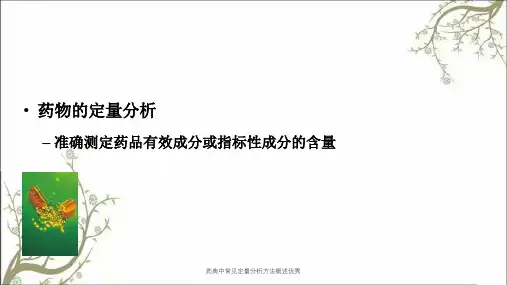
药物分析是以药品质量标准为依据,对药物中的相关成分、含量进行检测与分析,以对药品质量的优劣及真伪做出评定。
药物分析的主要方法包括化学物理的以及生物分析等方法。
汇总了药物分析中常用的8种检测方法,希望你能对你有所帮助。
药物分析是以药品质量标准为依据,对药物中的相关成分、含量进行检测与分析,以对药品质量的优劣及真伪做出评定。
药物分析检测可研究药品及其制剂的组成、理化性质、真伪鉴别、纯度检查及测定其有效成分的含量,并保证人们用药安全、合理、有效。
开展药物分析之前,需要配备适用的药品质量检测设备等仪器,这是保证药品质量检验工作开展的基础。
在进行药物分析时,需要严格遵守检验操作流程,保证药品质量检测结果准确可靠。
药品质量检验的样品包括药材原材料样品、辅料样品、半成品、包装材料、生产过程中产生的废物以及与药品直接或间接关系的材料等。
检验样品和方法需要经过相关授权人员和药品检验人员按规定操作验证,记录并完成检验报告后及时送审。
药物分析检测对于药物研发至关重要,通过药物分析方法可以了解药物的药效、主要成分及理化性质等。
药物分析的主要方法包括化学物理的以及生物分析等方法。
化学检验则是药品在化学分析仪器等一系列化学反应条件下所表现出来的化学性质、反应强度及其影响等,是现今药品质量检验检测中应用最为广泛、最主要的方法,能够综合全面的分析和评价药品的质量与效果。
物理检测方法是指通过电、热、光等常规物理条件作用下对药品的物理机械性能进行检验。
生物技术方法主要包括电泳技术和PCR技术等。
常见的药物分析方法如下:1、重量分析法重量分析法是药物分析检测中化学分析的基础方法,指的是称取一定重量的试样,用适当的方法将被测组分与试样中其他组分分离后,转化成一定的称量形式,称重,从而求得该组分含量的方法。
根据分离方法的不同,重量分析法通常分为沉淀重量法、挥发重量法、提取重量法和电解重量法,其优点是直接采用分析天平称量的数据来获得分析结果,在分析过程中不需要标准溶液和基准物质,也就不需要容量器皿引入数据,这样引入的误差较小,因此分析结果准确度较高。
The know-how packagefor titrimetric/potentiometric analyses of pharmaceutical ingredients with Metrohm Titrinos or Titrandos.Pharm PAC (Pharm aceutical P otentiometric A nalysis C ollection) presents all titrimetric methods that are de-scribed in the most important pharmacopeias. It takes into account the latest editions of:• European Pharmacopoeia, 4th Edition plus Supple-ment 2002• U.S. Pharmacopeia USP 26 NF-21, 2003Pharm PAC contains analytical procedures for 733 individual substances. The procedures give detailed information about: sample weight, titrant and solvent to be used, electrode, titration and finally calculation of the results.By taking over these methods directly as SOPs (S tan-dard O perating P rocedures) in you laboratory you will save both time and money.The procedure couldn’t be simpler:• For the instruments: 798 MPT Titrino, 799 GPT Titri-no, 785 DMP Titrino und 751 GPD Titrino (instrument software version 5.751.0020 or higher):Using the method memory card you load the Pharm PAC methods, i.e. the complete parameter sets, intoPharm PAC is indispensable for the analysis of active ingredientsyour Titrino, equip it with the corresponding Ex-change Unit and connect the required electrode. You then load the desired titration method into the working memory, prepare your sample and start the titration with the push of a key. After the sample weight has been entered and the titration is conclu-ded, the Titrino issues the titration curve and a com-plete result report on the connected printer.• For the instruments: 794 Basic Titrino, 716 DMS Tit-rino, 736 GP Titrino und 751 GPD Titrino (with instru-ment software version <5.751.0020):Using the demo version of Metrodata VESUV 3.0, which forms part of the delivery package, you load the methods into the Titrino with a PC. Then proceed as described above.• 808 and 809 Titrando:You can easily take over the Titrino parameters into your Titrando by means of the converter program contained in the PC Control software.The Pharm PAC know-how package comprises the application binder with detailed method descriptions, the method memory card, the Me-trodoc CD-ROM with the Pharm PAC titration methods as well as theMetrodata CD-ROM.Method symbols facilitate orientationTwo titration examples for your Metrohm titratorTitration curve for the determination of ephedrine hydrochloride according to method 6 (titration in ethanol with hydrochloride acid addition).Electrode: 6.0229.100 SolvotrodeTitrant: c(NaOH) = 0.1 mol/L Titration curve for the determination of acesulfame potassium according to method 13 (titration in glacial acetic acid) Electrode: 6.0229.100 SolvotrodeTitrant: c(HClO4) = 0.1 mol/L in glacial acetic acidA. Aqueous acid-base titrationsA 1 Direct titrationsA 1.1 Titrations with basesA 1.2 Titrations with acidsA 2 Indirect titrations (back-titrations)B. Nonaqueous acid-base titrationsB 1 Alkaline titrantsB 1.1 In ethanol, with HCl additionB 1.2 In dimethyl formamide (DMF)B 1.3 In acetoneB 1.4 In pyridineB 1.5 In ethanol or methanolB 1.6 In special solventsB 2 Acidic titrantsB 2.1 In glacial acetic acid, with HClO4B 2.2 In glacial acetic acid/acetic anhydride, withHClO4B 2.3 In acetic anhydride, with HClO4B 2.4 In glacial acetic acid plus Hg acetate, withHClO4B 2.5 In glacial acetic acid/MEK, with HClO4B 2.6 In formic acid/glacial acetic acid or acetic anhy-dride, with HClO4B 2.7 In other solvents or solvent mixtures C. Redox titrationsC 1 Iodine/thiosulfateC 2 Iodine/arseniteC 3 Diazotization with NaNO2C 4 Cer(IV)C 5 KBrO3C 6 KMnO4C 7 KIO3C 8 Determination of reducing sugarsD. Precipitation titrationsD 1 AgNO3D 2 Surfactant titrationsE. Photometric EDTA titrationsF. Characteristic values of fats and oilsF 1 Acid ValueF 2 Hydroxyl ValueF 3 Iodine ValueF 4 Peroxide ValueF 5 Saponification ValueG. Qualification of the titrator, validation of a titration methodQualification of the titrator and validation of a titration method illustrated by way of two examples (ephedrine hydrochloride according to Pharm. Europe and USP)List of methodsThe 35 methods in the memory card are arranged in groups A to G and contain the titer determinations of the titrants plus the following titrations:Scope of delivery6.6042.003 Pharm PAC, English version 6.6042.001 Pharm PAC, German versioneach one containing:• The printed collection with texts for the 35 methods. Each method is described in detail and comprises parameter sets and curve examples. The collection comes in an attractive application binder; method-specific images facilitate orientation.• Memory card containing the 35 methods for loading into the Titrino.• Two CD-ROMs with:– Contents of the above binder, i.e. with texts, parameter sets and curve examples (PDF).– The following Metrohm Application Bulletins:No. 101 Complexometric titrations with the Cu ISE No. 130 Chloride titrations with potentiometric indication No. 141 Analysis of edible fats and oils No. 188 pH measurement technique No. 206 Titer determination in potentiometry No. 210 Blank determination in titration No. 228 Diazotization titrationsNo. 233 Titrimetric/potentiometric determination of anionic and cationic surfactants No. 252 Validation of Metrohm titrators (potentiometric) according to GLP / ISO 9001No. 263 Titrimetric determination of pharmaceutical compounds with the NIO electrode No. 269 Titrimetric/potentiometric determination of ionic surfactants by two-phase titration us-ing the Metrosensor Surfactrodes– Demo versions of the Metrodata programs VESUV, TiNet, VA Database, IC Net etc., 6.6050.000 PC Control program (Titrandos) und Adobe Acrobat Reader for viewing and printing the PDFfiles.Ordering informationS u b j e c t t o m o d i f i c a t i o n s – P r i n t e d b y M e t r o h m L t d ., C H -9101 H e r i s a u , S w i t z e r l a n d – 8.013.6003 – 2003-05。